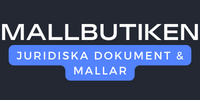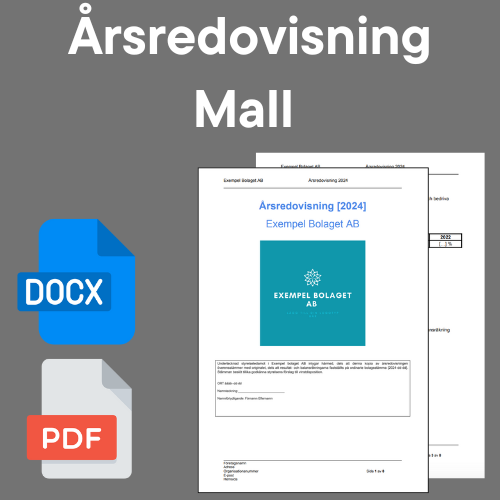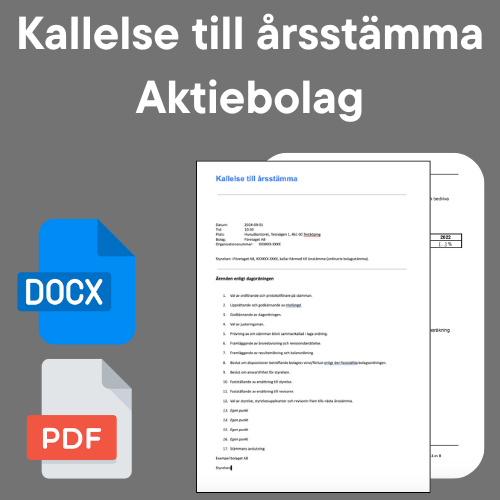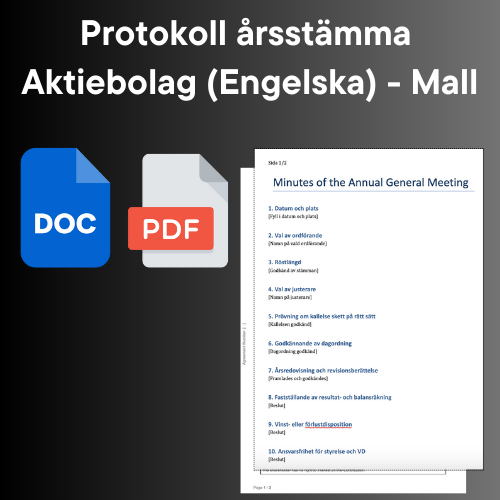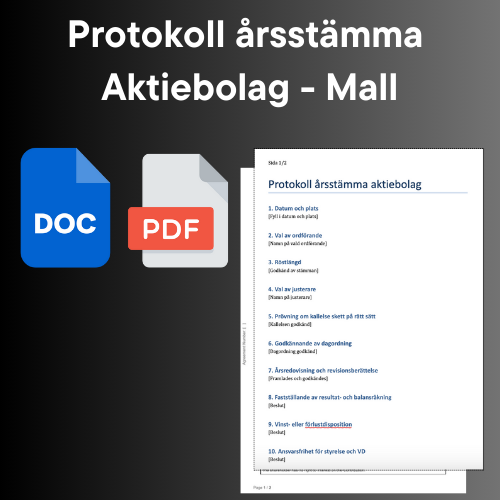Guide to annual reports in sole proprietorships
Share
Annual report for Sole Proprietorship
Table of Contents
- Introduction
- Annual Accounts and Simplified Annual Accounts
- Annual report
- Legislation and Practice
- Practical example
- Important Dates and Practical Tips
- Final Thoughts
Introduction
Annual accounts and financial statements are central components for individual companies in Sweden. The rules and requirements vary depending on the company's turnover and size. Here we go through the various aspects of annual reporting for individual companies, including legislation, practice, and examples and scenarios that illustrate how these rules are applied.
Annual Accounts and Simplified Annual Accounts
An individual company can end its financial year in different ways depending on turnover:
Simplified annual accounts
Simplified annual accounts apply to smaller individual companies with an annual net turnover of no more than three million kroner. A simplified annual account consists of a balance sheet and an income statement. It is easier to set up and complies with the Accounting Board's K1 regulations. The financial statements can be made electronically via the Tax Agency's e-service or manually on paper.
Regular annual accounts
If the turnover exceeds three million kroner, a regular annual account is required. This is more comprehensive and includes additional information to the balance sheet and income statement. Ordinary annual accounts are drawn up in accordance with the Norwegian Accounting Board's K regulations Annual accounts.
Annual report
In some cases, an individual company may be obliged to draw up an annual report. This applies if the company is considered larger, which means that it meets at least two of the following three criteria:
- More than 50 employees
- A balance sheet total of more than SEK 40 million
- A net turnover of more than SEK 80 million
An annual report is drawn up in accordance with the Accounting Board's K3 regulations. This annual report is more detailed and includes a management report, profit and loss account, notes, and in some cases a cash flow analysis.
Legislation and Practice
The legislation regarding financial statements and annual reports for individual companies is regulated by the Accounting Act (1999:1078) and the Annual Accounts Act (1995:1554). The Accounting Board provides guidance through various regulations, with K1 and K2 being the most common for smaller companies and K3 for larger companies.
The Accounting Act (1999:1078)
This law establishes that all business events must be recorded on an ongoing basis and that the accounting must end with a financial statement. For sole traders, this means a simplified annual account, a regular annual account or an annual report depending on the company's size and turnover.
Annual Accounts Act (1995:1554)
This law applies above all to larger companies that need to draw up an annual report. It requires that the annual report give a fair picture of the company's position and results and follow good accounting practice.
Practical example
Let's look at some scenarios to illustrate how these rules apply in practice.
Scenario 1: Small Sole Firm
Anna runs a small online store as a sole proprietorship with an annual turnover of SEK 2.5 million. She can draw up a simplified annual account. Her financial statements will consist of a balance sheet and an income statement according to K1 regulations. She uses the Tax Agency's e-service to simplify the process.
Scenario 2: Medium-sized sole proprietorship
Erik runs a consulting business with an annual turnover of SEK 4 million. Since his turnover exceeds three million kroner, he must draw up a regular annual account. In addition to the balance sheet and income statement, his financial statements also contain additional information, according to K regulations Annual financial statements (BFNAR 2017:3).
Scenario 3: Large Sole Firm
Lisa runs a construction company with an annual turnover of SEK 85 million and 60 employees. Her company is considered larger according to the Annual Accounts Act, and she must therefore prepare an annual report according to the K3 regulations. This includes a management report, notes, and a cash flow analysis. The annual report must also be submitted to the Swedish Companies Registration Office.
Important Dates and Practical Tips
Keeping track of important dates is essential for an accurate annual report. Here are some tips:
- Prepare well in advance: Collect all documents and reconcile balance accounts regularly to avoid stress at the end of the financial year.
- Use digital tools: Digital accounting software can simplify the process and ensure that all business events are properly recorded.
- Seek professional help if necessary: If your company grows and the accounting becomes more complex, it may be worth hiring an accounting consultant.
Final Thoughts
To draw up a correct financial statement and in some cases an annual report non-disclosure is crucial to keeping your sole proprietorship in good order and complying with the law. By understanding the different requirements and using the available resources, you can ensure that your business meets all the necessary regulations and continues to grow sustainably.
By following these guidelines and examples, you can navigate through the requirements placed on individual companies in Sweden, regardless of whether you run a small business or a larger company with high turnover.
